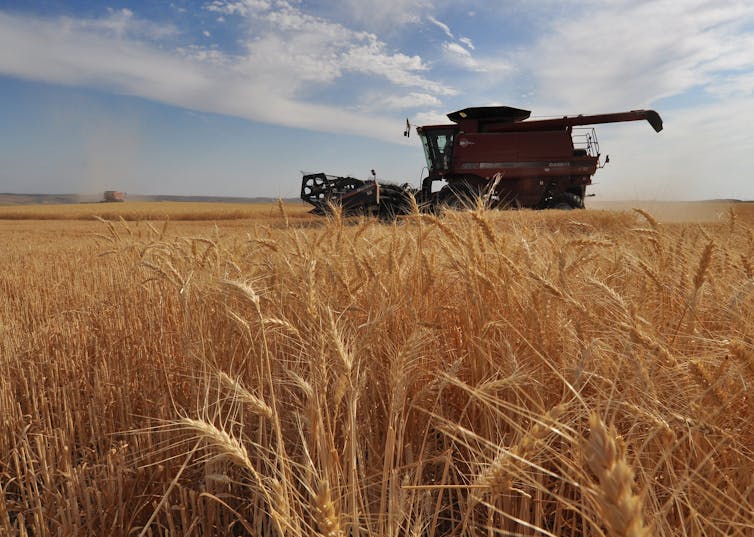How science and innovation can strengthen global food systems
Food systems, from production to consumption, are complex in nature and require co-ordinated efforts at different levels

Estimated reading time: 10 minutes
Chibuike Udenigwe, L’Université d’Ottawa/University of Ottawa
Food systems are the public policy decisions, the national and global supply chains and the public or private individuals and groups that influence what we eat.
Unfortunately, current global food systems are not sustainable. One in nine people are affected by hunger globally. This situation was worsened by the pandemic.
Global food systems currently do not prevent malnutrition. In fact, they can worsen nutrition and health outcomes with the high rates of obesity and related health issues caused by unhealthy diets. Food today also lacks sufficient nutrients.
Food systems affect the environment negatively, contributing about one-third of global greenhouse gas emissions from 1990–2015. They are susceptible to disruptions like the pandemic, the Russia-Ukraine war or any natural disasters. But science and innovation can offer a way out.
First steps toward scientific innovations
UN Secretary-General António Guterres convened the Food Systems Summit in 2021 with the goal of encouraging stakeholders to collaborate in making tangible, positive changes to global food systems.
With five action tracks, the summit focused on efforts towards achieving the UN Sustainable Development Goals related to food systems, especially Goal 2 (Zero Hunger).
Before the Summit, an independent Scientific Group was set up to provide input from the global scientific community. Information generated was used to recommend seven innovation priorities for transforming food systems. Three are directly related to food science and technology.
Innovations in food science and technology
Innovations in food science and technology are well-positioned to address many food systems challenges. Food processing has enabled nutrient preservation and the enhancement of sensory quality, safety and shelf life of food products. Food fortification — the process of adding micronutrients to food — helps meet specific nutritional needs to mitigate malnutrition.
1) Best out of waste:
The world wastes millions of tonnes of food every year. Reducing food waste and encouraging people to consume diets with lower carbon footprint would therefore be ideal. But since that seems too idealistic, processing technologies (like 3D printing) can be used to convert this waste into new food products, promoting efficient use of resources.

2) Food diversification:
Ongoing food diversification efforts include untapped resources (like millets and baobabs) that have high amounts of nutrients. These neglected, underutilized, minor or orphan crops should be consumed more. Using sustainable alternatives like marine-based foods and edible insects is also gaining popularity in some cultures.
Diversification can help reduce the overuse of the five big staples (maize, rice, wheat, potatoes and cassava) and widen the type of nutrients consumed. It can also encourage local food production, building resilience.
3) Sustainable food processing:
Food processing such as fermentation has proven to unlock the health benefits of food. There is strong scientific evidence that the active components of functional foods — foods that offer health benefits beyond their nutritional value — can prevent diseases like hypertension and Type 2 diabetes.
This preventative approach to health is largely underutilized.
Effective implementation equals success
The main task now is to efficiently implement these recommendations, especially in regions most affected by food insecurity.
Food systems policy initiatives mostly occur at the national and global levels, and community-level engagements can help increase the chances of sustaining their impact locally. Local engagement can also help gather and implement traditional knowledge and cultural beliefs that influence innovation.
This calls for inclusive approaches in gathering scientific data, including through citizen science. Data sharing in scientific journals should also expand to include unconventional methods and results, especially those of regional importance, that can expedite the solutions.
Interventions also need to be consumer-focused. Emerging innovations should be driven by public participation and input, instead of industry and funding priorities. Food is an emotive topic and involving the public in discussions on food systems can help reduce misinformation and encourage acceptance of innovations.
At the same time, the political will to drive innovation-focussed food systems locally and globally is also crucial. Industry should be required to prioritize innovations that sustainably produce food with direct public benefit.
Increased financial investment is also needed. The UN Food Systems Summit Scientific Group proposed that governments around the world should spend at least one per cent of their agricultural GDP on food systems science and innovation. This support should also be extended for the creation of small businesses and niche markets for unconventional food products, especially in rural communities and low- and middle-income countries.
Lastly, the complexity of food systems today requires the collaboration across different scientific disciplines and sectors when it comes to developing and implementing solutions. Academic and research institutions should therefore update their policies to adequately reward such collaborative approaches that stand a better chance of providing solutions than the status quo.![]()
Chibuike Udenigwe, Professor and University Research Chair in Food Properties and Nutrient Bioavailability, L’Université d’Ottawa/University of Ottawa
This article is republished from The Conversation under a Creative Commons license. Read the original article.
What's Your Reaction?
























